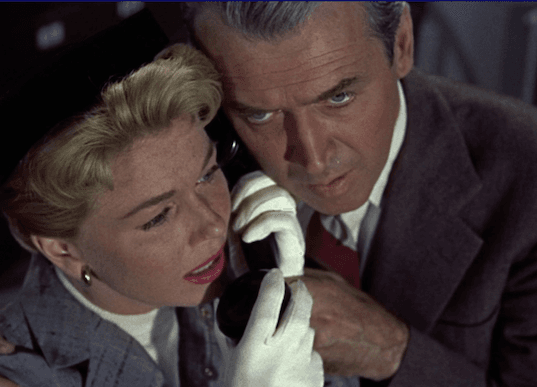Was Doris Day Too Spunky for Alfred Hitchcock?
America’s Sweetheart starred in only one film by the Master of Suspense, ‘The Man Who Knew Too Much,’ the centerpiece of ‘Hitchcock’s ’50s,’ a one-week series at Film Forum.

‘Hitchcock’s ’50s’
Film Forum
November 10-16
Doris Day starred in one and only one film by Alfred Hitchcock, “The Man Who Knew Too Much” (1956). Let’s do the stats: Grace Kelly featured in three of Hitch’s films, as did Ingrid Bergman, while Tippi Hedren and Vera Miles count for two films each. Then there was Madeleine Carroll in a pair of Hitch’s British films, “The 39 Steps” (1935) and “Secret Agent” (1936). She is often cited as the original “Hitchcock Blonde,” or, as some have it, the prototypical “icy blonde.”
Other actresses, though one-timers with Hitchcock, also fit the mold: Edna Best, Eva Marie-Saint, Kim Novak, Janet Leigh, and let’s not forget Karen Black wearing a wig on the model of Veronica Lake in Hitchcock’s last film, “Family Plot” (1976). Yet Day was different from these actresses: Blonde though she may have been, her presence in “The Man Who Knew Too Much” is, if not a sticking point, then notably off-topic. For what Day exuded was not iciness or glamor, but pluck. In the end, she may have proved too spunky for Hitchcock.
A newly restored version of “The Man Who Knew Too Much” is the centerpiece of “Hitchcock’s ’50s,” a one-week series at Film Forum that follows up on the soon-to-be-completed retrospective of the decade, “50 From the ’50s.” The Hitchcock program includes inescapable cinematic monuments like “Strangers on a Train” (1951), “Rear Window” (1954), “Vertigo” (1958), and “North By Northwest” (1959), as well as some that fall a smidgen below the standard: “To Catch a Thief” (1955) and “The Wrong Man” (1956).
Were the 1950s Hitchcock’s finest decade? The ’40s put up a good fight, with “Shadow of a Doubt” (1943) and “Notorious” (1946) leading the pack. The ’60s were heralded with “Psycho” (1960), arguably the Hitchcock film with the greatest reach and influence. Yet mid-century saw the erstwhile director on a roll that had to be the envy of his peers. Billy Wilder did right by movie fans during the decade, as did Anthony Mann and John Ford, with Howard Hawks a hair’s breadth behind them. If Hitch doesn’t stand alone, he is an integral component of an amazing run in Hollywood.

“Dial M for Murder” (1954) has been doing double duty at Film Forum, given that it’s also been screened as part of “A Deeper Look: Hollywood’s First 3-D Wave, 1953-1954.” Why this particular property was deemed worthy of the stereoscopic process likely has more to do with catching a wave than its mise en scène. Based on a stage play by Frederick Knott, the picture is heavy on dialogue and circumscribed in setting. Fortunately, the dialogue sparkles and Hitchcock lays out the parameters of the story’s environs to an almost fetishistic degree. Compared to something like “Rear Window,” “Dial M for Murder” is small beer. Still, it’s pretty fun.
That is, if you could buy into the notion that retired tennis player Tony Wendice (Ray Milland, supercilious and enjoying every minute of it) would want to kill Grace Kelly or, rather, his wife Margot. Tony is in receipt of a letter that confirms that Margo is having an affair with Mark Halliday (Robert Cummings). He calls Mark Swann (Anthony Dawson), an old school chum with a disreputable past. The back-and-forth between Tony and Mark is the best thing about the movie, with Milland and Dawson relishing every syllable of an improbably circuitous tête-à-tête. What follows afterward is a not-so-perfect crime elaborated upon and solved in the fashion of Agatha Christie.
Hitchcock had already made a version of “The Man Who Knew Too Much,” and the remake is equally abundant in suspense but also in comedy, reminding us of how vital humor was to Hitchcock’s vision. Dr. Benjamin McKenna of Indianapolis, Indiana (James Stewart), is vacationing in French Morocco with wife “Jo” (Day) and son Hank (Christopher Olsen). When Hank inadvertently removes a young woman’s niqāb — the scarf worn by Muslim women that covers the face — the all-American family incurs the wrath of her husband. Fortunately, Louis Bernard (Daniel Gélin), a suave but mysterious Farenchman, steps in to smooth things over.
Things rarely stay smooth for long in the Hitchcockian universe. The good doctor and his family are soon embroiled in an international intrigue that includes a planned assassination attempt on the British prime minister. Did I mention that “Jo” was a former star of the theater? It’s reason enough to allow Day to sing “Que Sera Sera” — not once, but twice. Should that sound like overkill, the second version is the hinge on a major plot point that also turns out to be quite funny in its execution.
Day brings to the proceedings her estimable gifts as a comedian and Stewart responds in kind. The story dawdles on for a good 45 minutes more than the original, but the keen pairing at its center makes it worth your time. That, and you get to enjoy America’s Sweetheart bedeviling the Master of Suspense. That alone is worth the price of admission.

